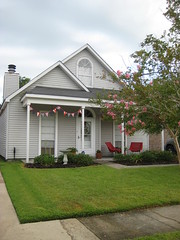But oh, how they can add up. At $20-40 (or more!) a pop, I can't fill my house with throw pillows the way I'd like.
Or so I thought!
Thanks to Apartment Therapy, I found these simple instructions. It seemed easy enough, so I headed out to a fabric store. I found a couple of great prints for 50% off. Score! I also picked up some coordinating solids for an art project. When I got home, I set to work.
First, you need to figure out your dimensions. I got two 18" square pillow forms for $4 at target, but you could recover an old pillow, just measure it first.
For the vertical, the fabric will be exactly the same width as the pillow. You don't want to leave a seam allowance, or the pillow will be floppy instead of full.
For the horizontal, multiple your dimension by two and add 4". So for an 18" square pillow, I ended up with 18x40 pieces of fabric.

If you're using a geometric pattern, like the blue square chain here, it is very important to keep everything straight and parallel. Luckily, you can use the pattern itself as a guide.
The next step is to create a rolled hem at each end. These hems will create the envelope opening on the back of the pillow.
First, fold the fabric over 1/4". Then fold over another 1/4" and pin.


Then, use a simple stitch to hem it down. This seam will be visible on the back of the pillow, so I tried to be as neat as possible.
Now you will have a long piece of fabric with a hem on each side. Fold each side in, keeping the wrong side of the fabric out. You want each side to overlap a bit, about 3 1/2". Measure your square, and make sure it's about a half inch less than your pillow's dimension.

Then pin the top and bottom, and sew the top and bottom edge using a simple stitch. Take special care near the envelope opening, making sure you "catch" all the layers of fabric.

Turn it inside out, and you've got a pillow cover!

These took under two hours start to finish. If I had a machine, it would have been easily under an hour. And it was so easy. And you know what?

It was so worth it.



